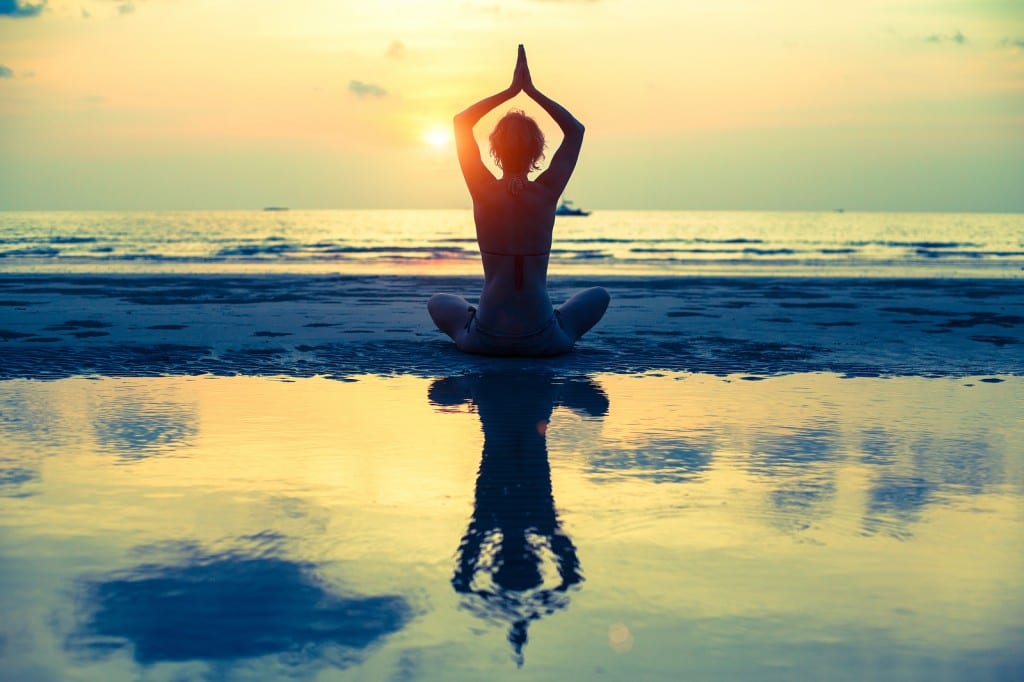As a yoga teacher, one of the most common questions I receive is how to start a meditation practice. So many people have heard about the incredible benefits of meditation and the choice to meditate seems easy, but beginning a practice at home is daunting. The process I recommend below is based on one of the most ancient yogic texts, the Yoga Sutras by Pantajali’s. The text is a map of how to approach the practice of yoga and access the blissful state that is within us always. The first line of this enlightening text is “Yoga Chitta Vritti Nirodaha,” roughly translated: “Yoga is the cessation of the mind Stuff.” The entire practice of yoga is designed to quiet the mind, or in other words, meditation.
Step One: Find a quiet space where you will not be disturbed. If it is uncomfortable to sit on the floor, find a chair where you can sit up tall with a nice long spine. If you like to sit on the floor, find a blanket or pillow to sit up on.
Step Two: Take moment to settle into your space. Whether standing or sitting, begin to gather your whole self and find presence. Take a few deep breaths, even sigh aloud, and do some gentle bouncing up and down: anything to help release thoughts and energy that you may bring with you to your meditation space.
Step Three: When you feel ready to settle, start with a bit of gentle stretching (be sure stretch the legs), round and arch the spine, twist and side bend. Listen to what your body calls for. Like scratching an itch – feel for what needs a little attention – and a bit more space.
Step Four: When the body feels opened up a bit, find a comfortable seat, whatever that means for you. Notice how you choose to sit, feel your spine and lengthen it, soften the shoulders away from the ears, release the jaw and brow and choose where to rest your hands: palms facing up if you need a little more inspiration, palms facing down if you could use more grounding. Begin by closing the eyes and observing the breath.
The breath is a wonderful anchor for the mind throughout meditation, so start here by noticing the gentle swell of the belly, side ribs, chest and back with the inhale – and the slow deflation on the exhale. Long, smooth inhales and exhales – finding a real sense of ease. There are many Pranayama (breath) techniques, but for the beginning, I recommend Apa Japa, which is gentle repetition awareness. Follow your waves of inhales and exhales and the relaxation response will start to kick-in, allowing you and your thoughts to soften. Sure, the mind will tug at your attention (that’s its job – the monkey mind!), but all you have to do is use the sensations of the breath to anchor yourself back in the present moment. If you become uncomfortable, feel free to move, but see if you can do so in a slow, mindful manner. Begin by sitting for five minutes and build from there. An ideal amount of time to sit is around 18 minutes.
Step 5: Slowly return. Start by deepening your breath and bringing sensation back into the physical plane. Hang on to that sensitivity and heightened awareness of every micro movement. As a teacher of mine once instructed, feel your eyelids slowly open. When your eyes are open, find a point in front of you to rest your gaze and take in the rest of the room. Unfurl your legs if they’re crossed, stretch, like you’re waking up and then slowly move into the rest of your day.
See if you can hang on to this peace, and carry this mindful awareness with you for the rest of your day.
- 5 Easeful Steps to Start Your Own Meditation Practice - September 14, 2014
- How to Find Some Stillness in a Life of Constant Movement - July 20, 2014
- Hush the Rush in 1-2-3 - February 25, 2014




